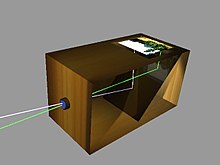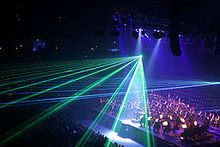The Muslim scientist, Ibn al-Haytham (965–1040), known as Alhacen or Alhazen in the West, developed a broad theory of vision based on geometry and anatomy in his Book of Optics (1021). Ibn al-Haytham provided the first correct description of how vision works, explaining that it is not due to objects being seen by rays of light emanating from the eyes, as Euclid and Ptolemy had assumed, but due to light rays entering the eyes. Ibn al-Haytham postulated that every point on an illuminated surface radiates light rays in all directions, but that only one ray from each point can be seen: the ray that strikes the eye perpendicularly. The other rays strike at different angles and are not seen. He conducted experiments to support his argument, which included the development of apparatus such as the pinhole camera and camera obscura, which produces an inverted image. Alhacen held light rays to be streams of minute particles that "lack all sensible qualities except energy" and travel at a finite speed.He improved Ptolemy's theory of the refraction of light, and went on to describe the laws of refraction, though this was earlier discovered by Ibn Sahl (c. 940-1000) several decades before him.[14][15]

He also carried out the first experiments on the dispersion of light into its constituent colors. His major work Kitab al-Manazir (Book of Optics) was translated into Latin in the Middle Ages, as well his book dealing with the colors of sunset. He dealt at length with the theory of various physical phenomena like shadows, eclipses, the rainbow. He also attempted to explain binocular vision, and gave an explanation of the apparent increase in size of the sun and the moon when near the horizon, known as the moon illusion. Because of his extensive experimental research on optics, Ibn al-Haytham is considered the "father of modern optics".

Ibn al-Haytham also correctly argued that we see objects because the sun's rays of light, which he believed to be streams of tiny energy particles[travelling in straight lines, are reflected from objects into our eyes. He understood that light must travel at a large but finite velocity, and that refraction is caused by the velocity being different in different

substances. He also studied spherical and parabolic mirrors, and understood how refraction by a lens will allow images to be focused and magnification to take place. He understood mathematically why a spherical mirror produces aberration.
Ibn al-Haytham's optical model of light was "the first comprehensive and systematic alternative to Greek optical theories."He initiated a revolution in optics and visual perception, also known as the 'Optical Revolution', and laid the foundations for a physical optics.As such, he is often regarded as the "father of modern optics."
Avicenna (980–1037) agreed that the speed of light is finite, as he "observed that if the perception of light is due to the emission of some sort of particles by a luminous source, the speed of light must be finite." Abū Rayhān al-Bīrūnī (973–1048) also agreed that light has a finite speed, and he was the first to discover that the speed of light is much faster than the speed of sound.[28] In the late 13th and early 14th centuries, Qutb al-Din al-Shirazi (1236–1311) and his student Kamāl al-Dīn al-Fārisī (1260–1320) continued the work of Ibn al-Haytham, and they were the first to give the correct explanations for the rainbow phenomenon.
René Descartes (1596–1650) held that light was a mechanical property of the luminous body, rejecting the "forms" of Ibn al-Haytham and Whitelo as well as the "species" of Bacon, Grosseteste, and Kepler.In 1637 he published a theory of the refraction of light that assumed, incorrectly, that light travelled faster in a denser medium than in a less dense medium. Descartes arrived at this conclusion by analogy with the behaviour of sound waves.[citation needed] Although Descartes was incorrect about the relative speeds, he was correct in assuming that light behaved like a wave and in concluding that refraction could be explained by the speed of light in different media.
Descartes is not the first to use the mechanical analogies but because he clearly asserts that light is only a mechanical property of the luminous body and the transmitting medium, Descartes' theory of light is regarded as the start of modern physical optics


0 comments:
Post a Comment